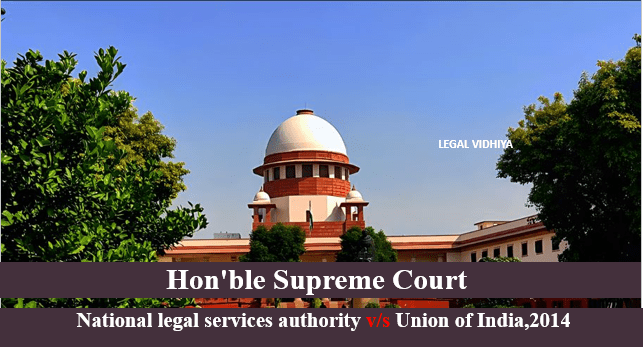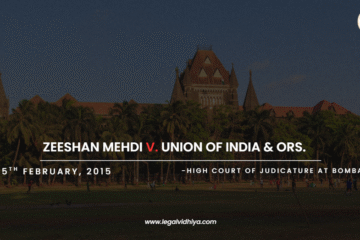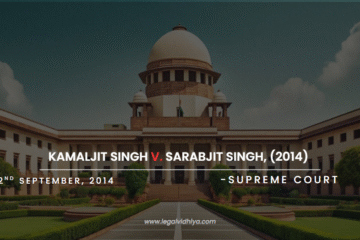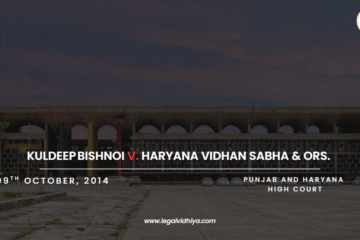
| Citation | AIR 2014 SC 1863 |
| Date of Judgement | 15/4/2014 |
| Court | Supreme Court of India |
| Case Type | Civil Original Jurisdiction |
| APPELLATE | National Legal Services Authority, Poojya Mata Nasib Kaur Ji Women Welfare Society, and Laxmi Narayan Tripathy. |
| Respondent | Union of India and Others. |
| Bench | S. Radhakrishnan and A. K. Sikri. |
| Referred | Art. 14,15,16,19 and 21 of the Constitution of India. |
ABSTRACT –
In this instance, the National Legal Service Authority of India filed a writ petition to have the legal status of “third gender” identities—those who do not fit neatly into either the male or female categories—recognized. According to the court, anyone who does not fit neatly into either the male or female gender binary can be considered a “third gender” individual. The court determined that ignoring non-binary gender identities constitutes a violation of the fundamental human rights that the Indian Constitution grants to every individual, no matter what gender. To find a resolution to the problem mentioned and render an impartial decision, the court submitted the matter to an Expert Committee on Transgender Issues that was established within the Ministry of Social Justice and Empowerment.
INTRODUCTION –
The world around us does not comprehend or even concern to comprehend the trauma, pain, and anguish a member of the transgender community must endure. Society never recognises or values the innate emotions of those who feel accepted to the transgender community, particularly those who have chosen to abandon their true gender. People tend to forget that the moral failure lies in the society’s unwillingness to contain or embrace different gender identities and expressions. We need to change the perspective of society. We observe that our society frequently mistreats the transgender community, especially in public places where these people are sidelined and treated as untouchables.
In this instance, examining the complaints that members of the transgender community have and requesting legal recognition of their gender identification are the key concerns. They argued before the court that the denial of their gender identification violated their rights as guaranteed by Articles 14 and 21 of the Indian Constitution. As third gender individuals with full legal and constitutional safeguards, Hijras also claimed legal status. The Yogyakarta Principles on Application of International Human Rights Law in Relation to Sexual Orientation and Gender Identity, as well as cases from foreign courts, supported this request for gender identity, and the court acknowledged the interrelationship of the right to privacy with these international instruments.
In this case, the court maintained everyone’s right to self-identify their gender and also ruled that Hijras should be recognised as “Third Gender” under the law. The court determined that “gender identity did not refer to biological characteristics but rather [was] referred to as a natural perception of one’s gender” and held that no third-gender people should be exposed to any medical examinations or biological tests that would infringe in any way on their right to privacy.
A member of the women’s welfare society named Poojya Mata Nasib Kaur Ji also filed Writ Petition No. 604 of 2013 to demand the fundamental rights of the Kinnar or transgender community. The National Legal Services Authority, which was established under the Legal Services Authority Act, 1997 to provide free legal aid to the weaker and other marginalised sections of society, came forward to fight for their rights.
The court’s ruling in this case was one of the most significant in judiciary history since it was the first time non-binary gender identities were acknowledged legally in India and the Fundamental Rights of transgender people were upheld. Gender identity was also extensively examined. The court ruled that third-gendered people have the same fundamental rights as everyone else under Indian law and international law, and it also gave state governments instructions to create the legal framework necessary to defend the rights of transgender and third-gendered people.
FACTS OF THE CASE –
On behalf of the transgender community, the National Legal Services Authority (NALSA) petitioned the Supreme Court of India for legal recognition and protection of their rights. The main contention in the case is whether transgender people ought to have legal protection under the Indian Constitution as a third gender and recognised as such. The petitioner claimed that the transgender community experiences prejudice and marginalisation in a number of areas, including health care, housing, work, and academia.
ISSUES RAISED –
- Should the Indian Constitution grant legal protection to transgender people and acknowledge them as a third gender?
- Whether transgender people’s fundamental rights are being violated by the prejudice they experience in a variety of spheres of life?
ARGUMENTS OF THE PETITIONER –
- The Indian Constitution needs to acknowledge the transgender people as a third gender and provide them with legal protection.
- The Indian Constitution does not fully address the rights of the transgender people, who lack legal recognition and protection.
- The transgender community experiences prejudice and exclusion in a number of areas of life, including employment, healthcare, housing, and education.
- Transgender people’s fundamental rights under the Indian Constitution, such as the right to equality, dignity, and non-discrimination, are violated when they are the target of discrimination.
- The court should step in to protect the rights of the transgender community since the Indian government has not done enough to address the prejudice and marginalisation they experience.
- Transgender people lack legal protection due to the binary gender classification of male and female in the law, which does not account for the variety of gender identities and expressions in India.
ARGUMENTS OF THE RESPONDENT –
- Due to the tiny size and social exclusion of the transgender minority, their rights do not require any special legal protection.
- Since transgender people may be identified using the current categories of male or female, it is neither practical or required to include a distinct gender category for them on official papers.
- The administrative division of gender into male and female is required; the recognition of a third gender would be confusing and problematic.
- Any additional actions should only be made after careful deliberation and consultation. The Indian government has already taken certain measures to address the difficulties encountered by the transgender population, such as offering reservations in employment and education.
- All Indian citizens, including transgender people, already have adequate protection and fundamental rights guaranteed by the Indian Constitution.
These arguments were made by the respondent during the case’s hearing, and the Supreme Court of India took them into account when it rendered its decision. The petitioner argued that the transgender community should be recognised as a third gender and given legal protection under the Indian Constitution, however the court ultimately rejected the respondent’s arguments and backed the petitioner’s position.
RATIO DECIDENDI –
According to the Indian Constitution, the fundamental right to dignity and personal autonomy includes the right to self-identify as a certain gender. The legal distinction between male and female does not fully account for the variety of gender identities and manifestations in India, and transgender people are not given any legal protection as a result. The Indian Constitution ought to recognise the transgender people as a third gender and provide them with legal protection. Transgender people’s fundamental rights under the Indian Constitution, such as the right to equality, dignity, and non-discrimination, are violated when they are the target of discrimination.
The Indian government has a responsibility to take positive action to address the marginalisation and prejudice experienced by the transgender population, including making sure they have access to essential rights like healthcare, education, and work. People who identify as transgender should be treated with respect and dignity and should enjoy the same freedoms and opportunities as other citizens, free from prejudice or marginalisation.
The Supreme Court’s landmark decision in the NALSA v. Union of India case, which recognised the legal status of transgender people and their ability to self-identify as male, female, or third gender, was built on these ideas. The lawsuit has been viewed as an important step towards greater inclusivity and equality for all people in the nation and assisted in securing legal recognition and protection for the rights of the transgender population in India.
JUDGEMENT –
In order to properly safeguard and defend their rights under the Constitution, the court’s decision honoured the rights of homosexual people as a third gender distinct from the gender binary. The Court went on to say that one of the most fundamental components of one’s identity and of one’s right to self-determination, dignity, and independence was gender identification. In addition, it was reiterated that medical treatments couldn’t be a requirement for the legal recognition of gender identification and that psychological gender should always prevail over biological gender.
The Court made reference to the fact that “Transgender is generally described as an umbrella term for persons whose gender identity, gender expression, or behaviour doesn’t conform to their biological sex” and that it has “become an umbrella term that’s used to describe a wide range of identities and experiences, including but not limited to pre-operative, post-operative, and non-operative transsexual people, who strongly identify with the gender opposite to the biological gender.”
The Court also discussed the rights against sequestration found in Articles 12 of the Universal Declaration of Human Rights and Article 17 of the International Covenant on Civil and Political Rights. The Court ruled that the provisions of these international conventions must be upheld to defend and preserve the community’s rights in the absence of any explicit legislation relating to the recognition of a third gender in India or any domestic law to the contrary.
The Court determined that gender identity was a fundamental aspect of existence and would be protected by Articles 19 and 21 of the Indian Constitution as a result of freedom of expression, seclusion, and quality. The legal acknowledgment of gender identity was regarded as a component of the right to quality and freedom provided by Article 21 of the Constitution, and the segregation, tone-identity, autonomy, and specific integrity of the transgender population were all reinforced.
The Court emphasised the need for third gender recognition in law as well as transgender people’s right to self-identification. The Court instructed the State to respect transgender people’s right to self-identification and to refrain from treating them as being socially and educationally behind others in order to provide reservations. The Court further ordered the State to run HIV Sero-surveillance Centres as transgender people had a variety of sexual health difficulties and to take the community’s mental health challenges, such as depression, gender dysphoria, shame, and other issues, very seriously. Other directions included improving medical care, increasing public awareness, and developing social welfare programmes. The Court additionally ordered the government-established Expert Committee to review the ruling and put its recommendations into action within six months.
By this ruling, third gender would be recognised on all official documents, including passports and ration cards. The Court further ruled that regardless of their population, transgender people are Indian citizens and have a full right to participate in any government services and programmes. Currently, the Indian Election Commission has also taken extra steps to sign up. “Our society rarely realises or cares to realise the trauma, agony, and pain which the members of the Transgender community experience, nor does it appreciate the innate feelings of the members of the Transgender community, especially of those whose mind and body disown their biological sex,” Justice Radhakrishnan writes in his ruling in the NALSA case, acknowledging this fact.Our society frequently makes fun of and mistreats the transgender community, and in public places like train stations, bus stops, schools, workplaces, malls, theatres, and hospitals, they are shunned and treated as untouchables. However, we must not lose sight of the fact that society’s moral failure stems from its refusal to contain or embrace various gender identities and expressions. This is a text that is permeated with empathy, from Justice Radhakrishnan’s opening remarks about society’s moral failure to contain or embrace various gender identities and expressions to Justice Sikhri’s awareness of the difficult process of transitioning from one gender to another.
CONCLUSION –
This case established a precedent by being the first in India to recognise non-binary gender identities and uphold the fundamental rights of those who identify as transgender. The court’s ruling compelled both the federal and state governments to take proactive measures to protect the rights of transgender people.
It worked out well that there is now a ruling designating a distinct gender as transgender. Although they have won a tiny battle, the transgender community still has a long way to go in their efforts to alter society’s mentality. “It seemed changing people’s mindsets would take longer,” said Guari Sawant, who asked to be called Hijra instead of being labelled either a man or a woman. I am at the centre of it. She asserted, “I’m not an alien.” She stated that she attempted to find joy in life’s minor pleasures even as the fight for transgender rights continued.
In addition, the court ordered the government to take action to remove the prejudice and marginalisation of the transgender minority and guarantee its access to fundamental freedoms and opportunities. The case sparked efforts to address these problems through policy and social reform and raised awareness of the prejudice and marginalisation transgender people experience in India.
REFERENCES –
- https://blog.ipleaders.in/national-legal-services-authority-vs-union-of-india-case-study/.
- https://legalvidhiya.com/nalsa-v-union-of-india-2014-scc-438/.
- https://lawfoyer.in/national-legal-services-authority-v-union-of-india/.
Written by Shashank Sandesh Verma an intern under legal vidhiya.




0 Comments